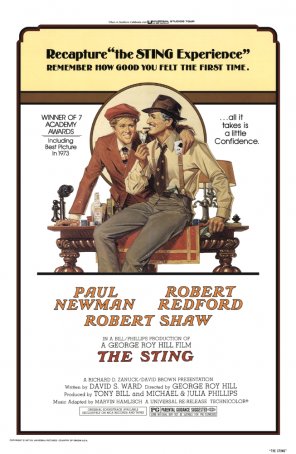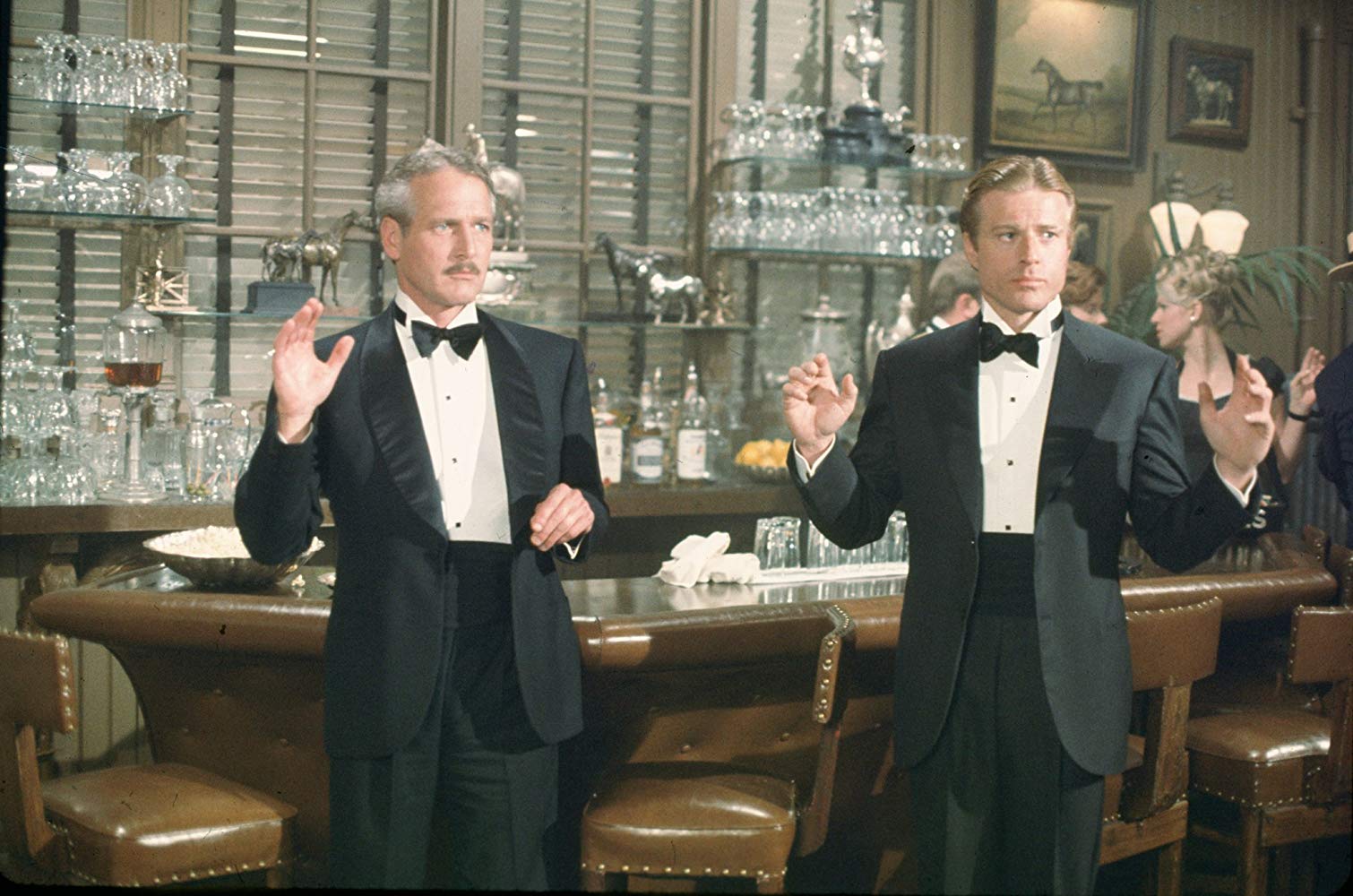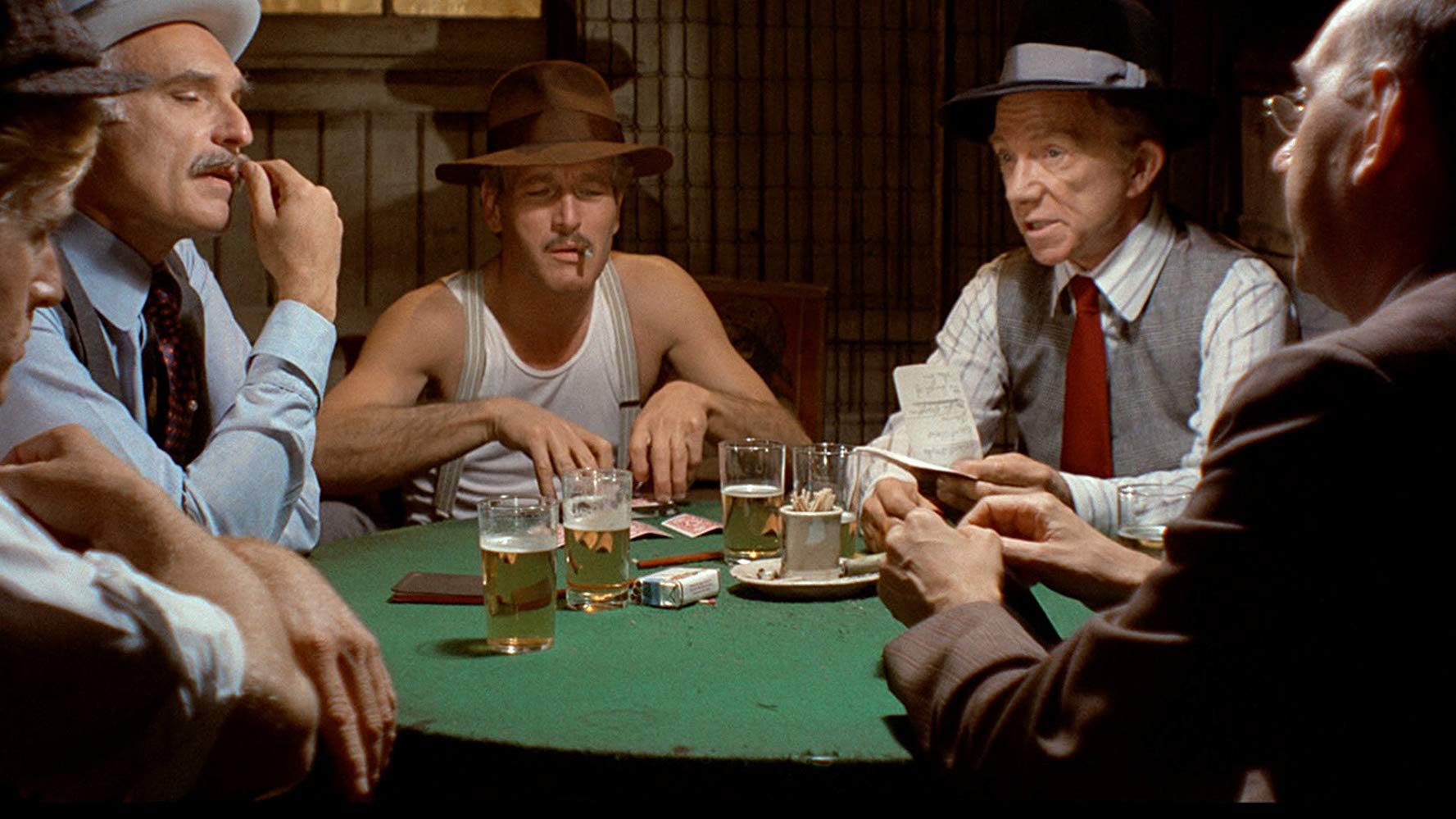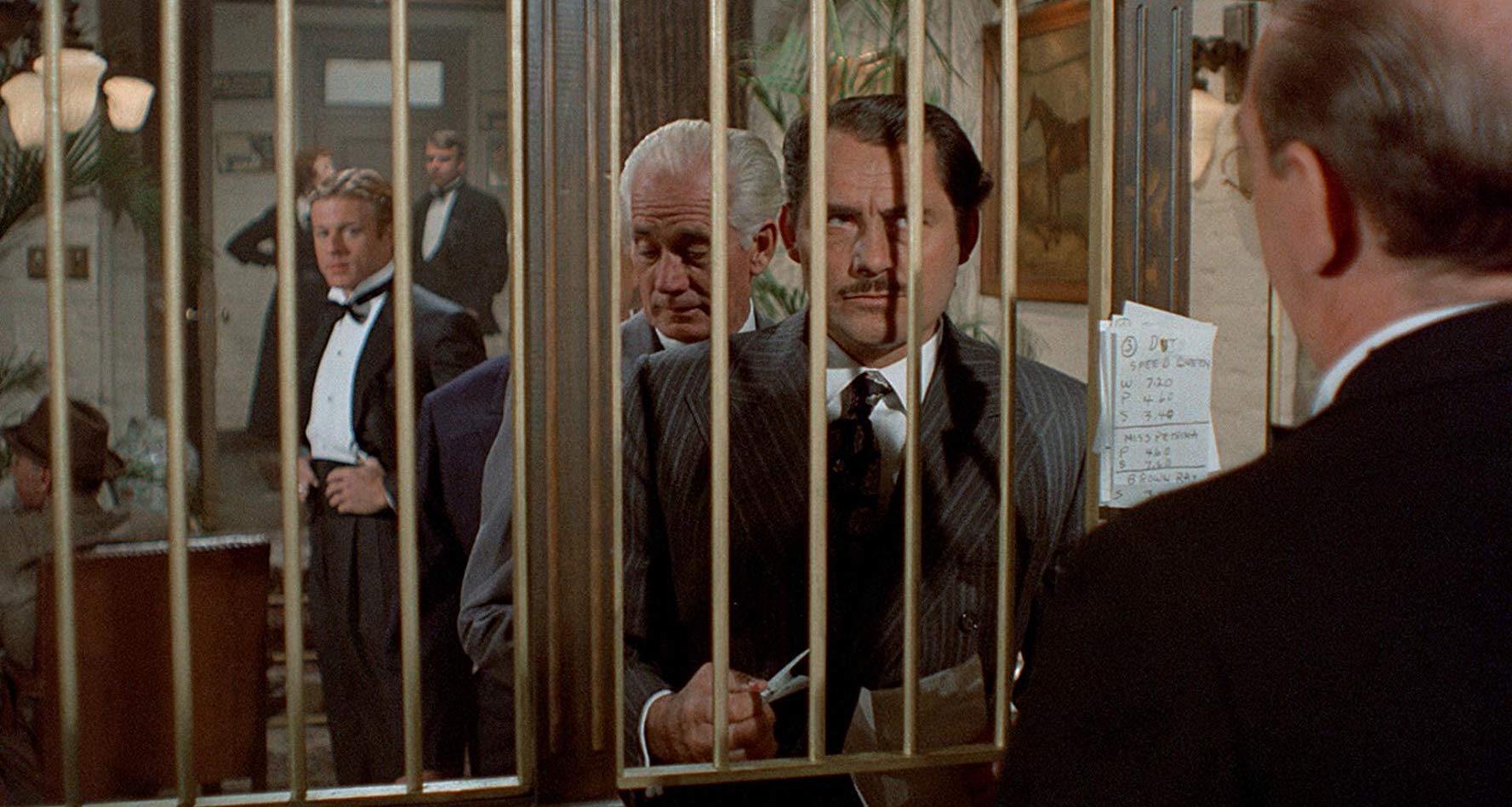Sting, The (United States, 1973)
July 09, 2019
This review contains oblique spoilers. Since it’s a con movie, even unspecific revelations could potentially spoil aspects of the viewing experience. Keep that in mind if you choose to read on…
Butch and Sundance ride again! Re-united with George Roy Hill, their director from the landmark 1969 film, actors Paul Newman and Robert Redford proved that their on-screen chemistry in Butch Cassidy and the Sundance Kid wasn’t a one-off. Despite how well the duo was received in The Sting, this would prove to be their final collaboration (even though Newman would continue working for another 29 years). Attempts to re-team them over the years never came to fruition.
The Sting adopts the playful, quasi-comedic tone
evident throughout much of Butch Cassidy. On the whole, however, this is
a more upbeat endeavor – an exploration of a long con devised and executed by
two Depression-era grifters, Henry Gondorff (Newman) and Johnny Hooker (Robert
Redford), and a team assembled by the former. Their mark, Doyle Lonnegan, is
played by Robert Shaw at his snarling best. The
Sting represents one of three
roles for which Shaw remains known long after his untimely death (the other two
being From Russia with Love and, of course, Jaws).
 In developing The Sting, Hill determined that he wanted the movie not only to be set in 1936
but to have the same feel as a movie crafted during that era. To that end, he
used the “old style” Universal logo, instructed his costume and set designers
to copy ‘30s movie templates for their work, and employed title cards that
mimicked the look of Saturday
Evening Post illustrations. For
the musical score, he anachronistically relied on the jazz piano rags of Scott
Joplin (arranged by Marvin Hamlisch, who also provided two new compositions).
Although Joplin wrote the material used in The Sting during the early
years of the 20th century, Hill believed it accomplished the goal of
giving the film an old-time, upbeat flavor. No stranger to odd musical choices
(“Raindrops Keep Falling on My Head” in Butch Cassidy), Hill was
willing to go in an unconventional direction. It proved to be a successful
choice – not only was the score one of the most remarked-upon aspects of The Sting but it contributed to a 1970s resurgence in Joplin’s popularity.
In developing The Sting, Hill determined that he wanted the movie not only to be set in 1936
but to have the same feel as a movie crafted during that era. To that end, he
used the “old style” Universal logo, instructed his costume and set designers
to copy ‘30s movie templates for their work, and employed title cards that
mimicked the look of Saturday
Evening Post illustrations. For
the musical score, he anachronistically relied on the jazz piano rags of Scott
Joplin (arranged by Marvin Hamlisch, who also provided two new compositions).
Although Joplin wrote the material used in The Sting during the early
years of the 20th century, Hill believed it accomplished the goal of
giving the film an old-time, upbeat flavor. No stranger to odd musical choices
(“Raindrops Keep Falling on My Head” in Butch Cassidy), Hill was
willing to go in an unconventional direction. It proved to be a successful
choice – not only was the score one of the most remarked-upon aspects of The Sting but it contributed to a 1970s resurgence in Joplin’s popularity.
Although aspects of
The Sting were based on the exploits of several
real-life grifters, this is a very Hollywood type of con movie, complete with a
big twist at the end. The last-act surprise is so smoothly incorporated into
the screenplay that even those who are expecting something may be
unprepared for what actually happens. Contemporaneous audiences were heard to
gasp and cheer at the film’s last-minute revelations. (Although I won’t reveal
specifics here, acknowledging the existence of a twist could be considered a spoiler
in its own rights.)
 The Sting opens by introducing low-level grifters
Johnny Hooker (Redford) and his partner, Luther Coleman (Robert Earl Jones,
James Earl Jones’ father), who operate their cons out of Joliette, Illinois.
When misfortune makes a numbers runner one of their victims, they appear to
strike it rich – until the boss of the organization, Lonnegan, hits back hard.
Hooker slips through Lonnegan’s fingers but Luther isn’t as lucky. Hooker leaves
Joliette for Chicago, pursued not only by a pair of Lonnegan’s thugs but by
corrupt cop Snyder (Charles Durning). In Chicago, Hooker looks up a “contact”
provided to him by Coleman before the latter’s death. The man, a one-time “big”
con artist named Henry Gondorff (Newman), is intrigued by Hooker’s proposal of
getting Lonnegan and sets out to determine how it can be done.
The Sting opens by introducing low-level grifters
Johnny Hooker (Redford) and his partner, Luther Coleman (Robert Earl Jones,
James Earl Jones’ father), who operate their cons out of Joliette, Illinois.
When misfortune makes a numbers runner one of their victims, they appear to
strike it rich – until the boss of the organization, Lonnegan, hits back hard.
Hooker slips through Lonnegan’s fingers but Luther isn’t as lucky. Hooker leaves
Joliette for Chicago, pursued not only by a pair of Lonnegan’s thugs but by
corrupt cop Snyder (Charles Durning). In Chicago, Hooker looks up a “contact”
provided to him by Coleman before the latter’s death. The man, a one-time “big”
con artist named Henry Gondorff (Newman), is intrigued by Hooker’s proposal of
getting Lonnegan and sets out to determine how it can be done.
The majority of the film focuses on the mechanics of the
con, which is based on an outdated setup called “The Wire.” Gondroff recruits a
number of the best men in and around Chicago and sets up a fake off-track
betting parlor. He then poses as a Chicago bookie and buys his way into a poker
game in which Lonnegan is playing. Gondroff “out-cheats” Lonnegan to win the
game, thereby creating animosity. The gangster is ripe for the picking when
Hooker, pretending to be a disaffected employee of Gondroff’s, approaches him
with a too-good-to-pass-up deal. The hook is baited but there’s still a
contract on Hooker’s life and the FBI wants to bring down Gondroff.
Like many of the
best heist/con movies, The Sting boasts a strong screenplay anchored by a
light tone and a breezy pace. The film doesn’t get too bogged down in details
but there’s enough uncertainty about who’s double-crossing whom to build some
degree of tension. Newman and Redford’s chemistry is as strong (if not
stronger) than in Butch Cassidy.
The period detail is impeccable. It’s hard to believe this was made 40 years
after the period in which it’s set. The decision to use Joplin’s tunes (especially
“The Entertainer,” which was colloquially known as “The Theme from The Sting”
in 1974) was a stroke of brilliance. The Sting wouldn’t have had the
same flavor without that music.
 The Sting was a major player during the 1974 Oscars
ceremony. Not only did it win Best Picture, but it captured another six awards,
including a Best Director for Hill (his only win and second nomination – the other
being for Butch Cassidy) and Best Music (for Marvin Hamlisch). Redford
was nominated in the Best Actor category (Newman, however, was passed over). He
didn’t win and this marked the only time in his long and storied career that he
received an acting nomination. (His two other nominations and lone win were in
the Director category.)
The Sting was a major player during the 1974 Oscars
ceremony. Not only did it win Best Picture, but it captured another six awards,
including a Best Director for Hill (his only win and second nomination – the other
being for Butch Cassidy) and Best Music (for Marvin Hamlisch). Redford
was nominated in the Best Actor category (Newman, however, was passed over). He
didn’t win and this marked the only time in his long and storied career that he
received an acting nomination. (His two other nominations and lone win were in
the Director category.)
In many heist movies, we end up rooting for the criminals, and The Sting is no exception. The film gets around any moral qualms by making Gondroff and Hooker’s mark a really bad guy. Lonnegan has no redeeming qualities so we’re relieved of any pangs of conscience for hoping he gets fleeced. Likewise, the film’s bastion of law & order, Snyder, is as reprehensible as they come. The grifters are presented as upstanding men with a code of honor who make their money by preying on the greed of others. All of this contributes to the upbeat feeling delivered by the crowd-pleasing resolution. The Sting represents one of the most popular, widely-loved films to win Best Picture in the last half-century and an example of grand entertainment. (Its sequel, however, made in 1983 with none of the original participants returning, is best ignored as the ignoble failure it is.)
Sting, The (United States, 1973)
Cast: Paul Newman, Robert Redford, Robert Shaw, Charles Durning, Ray Walson, Eileen Brennan, Harold Gould
Home Release Date: 2019-07-09
Screenplay: David S. Ward
Cinematography: Robert Surtees
Music: Marvin Hamlisch, Scott Joplin
U.S. Distributor: Universal Pictures
U.S. Release Date: 1973-12-25
MPAA Rating: "PG" (Violence, Profanity)
Genre: Thriller
Subtitles: none
Theatrical Aspect Ratio: 1.85:1
- Twilight (1998)
- (There are no more worst movies of Paul Newman)
- (There are no more worst movies of Robert Shaw)

Comments